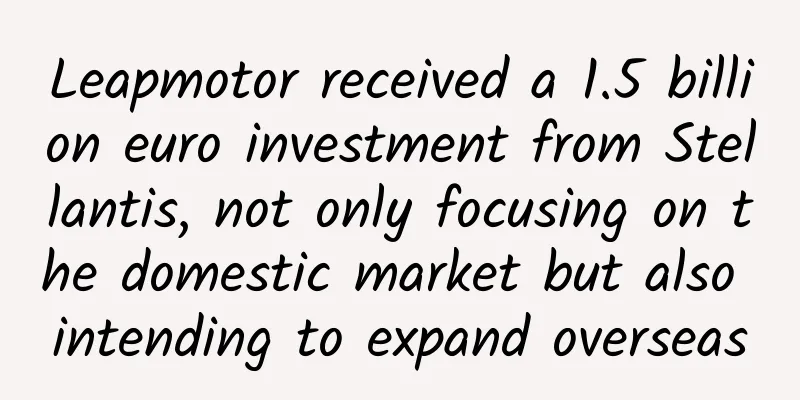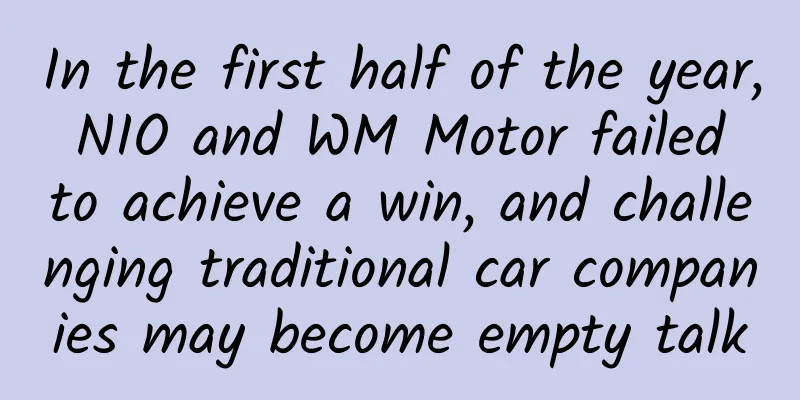Leapmotor received a 1.5 billion euro investment from Stellantis, not only focusing on the domestic market but also intending to expand overseas

|
Chinese car companies have formed an alliance again! This time it is Leapmotor and Stellantis Group. The name may sound unfamiliar, but almost everyone knows the brands under it. Maserati, Chrysler, Citroen, Jeep, Opel and other car brands were all born here. On October 26, Leapmotor announced that Stellantis Group plans to invest about 1.5 billion euros to acquire about 20% of its equity, which is about 11.58 billion yuan at the current exchange rate. The two parties will also establish a joint venture company called Leapmotor International with a ratio of 49% and 51%, and Stellantis Group will appoint the CEO of the Leapmotor International joint venture. Compared with the cooperation between Volkswagen and Xiaopeng in July, the cross-border cooperation of Leapmotor this time has a wider scope, and the joint venture established by the two parties will sell in regions outside the Chinese market. In the view of Zhu Jiangming, chairman of Leapmotor, "Only through a complete cooperation model can Chinese cars go beyond China and go global." "Mutual trust is very important", Leapmotor wants to be truly globalAccording to the announcement, the total capital commitment made by both parties to the joint venture is 20 million euros. Leapmotor must pay 49% of the total capital commitment, or 9.8 million euros in cash, and Stellantis must pay 51% of the total capital commitment, or 10.2 million euros in cash. It is understood that the joint venture plans to start foreign export business in the second half of 2024. Except for Greater China, the joint venture has the exclusive right to conduct export and sales business to all other markets in the world, as well as the exclusive right to manufacture Leapmotor products locally. Regarding this share allocation, Zhu Jiangming pointed out, "What is more important in this arrangement is mutual trust. We believe that 1+1>2, and we can better play our respective roles." The Stellantis Group, which owns French and Italian car brands such as Citroen, Peugeot, Jeep, and Alfa Romeo, covers the market from the high-end to the mass market, with customers in more than 130 countries around the world. It not only has strong financial strength, but also abundant channel resources, which is undoubtedly the best choice for the "cash-short" Leapmotor. Leapmotor said that 40% of the investment from the Stellantis Group will be used to expand and upgrade the smart electric vehicle portfolio, expand the R&D team, and improve electrification technology, 25% will be used for marketing, expanding sales and service networks, 15% will be used to improve production capacity and automation capabilities, and the remaining 20% will be used for operating funds. At the same time, Zhu Jiangming admitted, "Our cooperation with Stellantis is more about taking advantage of their business philosophy of 'multi-brand', using all channel resources, such as various mature networks such as finance, insurance, and services. Adding a Leapmotor brand to the 14 brands can quickly seize the market, develop globally, and provide better services to Leapmotor's product users." As Zhu Jiangming said, cooperation is based on mutual trust. So, what can Stellantis gain from cooperating with Leapmotor? Although Stellantis Group is the world's fourth largest automobile manufacturer, its development in China has not been smooth. Although Dongfeng Group launched a wave of price cuts at the beginning of the year, it is still difficult to save itself by price cuts in the market environment of "buy high and don't buy low." "Stellantis needs a certain exposure in the Chinese market, and Leapmotor ranks high in the industry. Our original intention is to help Leapmotor develop and promote its development in China and overseas so that we can penetrate the world's largest market," said Carlos Tavares, global CEO of Stellantis Group. Leapmotor has LEAP3.0 innovative technologies represented by the "four-leaf clover" central integrated electronic and electrical architecture, CTC batteries, and a new oil-cooled electric drive, as well as an excellent cost-effective electric vehicle ecosystem, which can help Stellantis achieve the electrification goals in its "Dare Forward 2030" strategic plan. In March 2022, it released the "Dare Forward 2030" strategic plan, intending to invest more than 50 billion euros. By 2030, all passenger cars sold by the group in Europe will be pure electric vehicles, and 50% of passenger cars and light trucks sold in the United States will be pure electric vehicles. Cooperate with multinational automakers and go overseas to find growth pointsAs mentioned above, although this cooperation between the two parties has become the largest single investment by overseas automakers in China's emerging forces, it is not the first case of marriage with multinational automakers. The cooperation between Volkswagen and Xiaopeng in July this year seems like yesterday. The cooperation between Volkswagen and Xpeng marks the beginning of a "reverse joint venture" between a century-old multinational automaker and China. Volkswagen Group invested approximately US$700 million in Xpeng Motors and acquired approximately 4.99% of Xpeng Motors' equity at a price of US$15 per ADS (American Depositary Share). After the transaction is completed, Volkswagen Group will obtain an observer seat on the board of directors of Xpeng Motors. However, unlike the cooperation between Leapmotor and Stellantis, Xpeng Motors and Volkswagen Group are jointly developing two B-class electric vehicle models based on their respective core competitiveness and Xpeng Motors' G9 platform, smart cockpit and advanced driver assistance system software, with the goal of selling them in the Chinese market under the Volkswagen brand. This means that Leapmotor's cross-border cooperation goes further. The fact that new domestic car manufacturers have chosen to cooperate with multinational car companies is the result of the combined effect of their own development and the external environment. First of all, judging from the development of various new forces, although they are developing rapidly, most of them are in the stage of burning money to find a way out, and their shortcomings are still quite obvious. Taking Leapmotor as an example, in the third quarter of 2023, Leapmotor achieved operating income of 5.656 billion yuan, a year-on-year increase of 31.9%; the net loss was 986 million yuan, a loss of 1.34 billion yuan in the same period of 2022, and a loss of 1.143 billion yuan in the second quarter of 2023, with a slight narrowing of year-on-year and month-on-month losses. However, in the first three quarters, Leapmotor's total operating loss has reached 3.359 billion yuan, and the loss of a single vehicle has reached 37,800 yuan. Leapmotor's current models include T03 (mini car, 59,900-99,500 yuan), C01 (C-class sedan, 149,800-286,800 yuan), and C11 (B-class SUV, 149,800-239,800 yuan). Among them, the T03, which is priced at 100,000 yuan, is the main sales force, while the sales of Leapmotor C11 and C01 are in the climbing stage, which has led to an embarrassing situation of "the more it sells, the more it loses." In the third quarter of this year, Leapmotor generated net cash of 1.4 billion yuan from operating activities, compared with 2.762 billion yuan in the second quarter; free cash flow was 1.018 billion yuan, also a sharp drop from 2.502 billion yuan in the second quarter. Zhu Jiangming had set the time node for Leapmotor to achieve its profit target at 2025, and the investment from Stellantis Group poured down like timely rain. Secondly, with the advent of the new energy vehicle era, the external environment has changed. Overseas automakers are cautious and slow in their attitude towards intelligence and electrification. They have begun to seek "investment in exchange for technology" in the hope of bringing the technological advantages of Chinese automakers in electrification transformation to the local market. On the same day that Stellantis and Leapmotor Investment made their official announcement, the European Commission also announced that it had selected BYD, SAIC Group and Geely Automobile as target companies to launch an anti-subsidy investigation. Faced with the rapid growth of China's automobile exports, Europe showed a sense of crisis. For Chinese automakers, seeking new growth points overseas in the context of the globalization of new energy, whoever seizes the opportunity may be able to write more stories. Data shows that in 2022, China's new energy vehicle sales will reach 6.89 million, a year-on-year increase of 93%, and sales have ranked first in the world for eight consecutive years; the new car penetration rate exceeds 25%, completing the 2025 planning target three years ahead of schedule. In addition, in the first half of this year, the European market has accounted for 39% of China's automobile exports, exceeding the Asian and North American markets. Domestic new energy vehicle companies are collectively "going overseas" because they are eyeing the huge market in Europe, especially Western Europe. According to data from the China Association of Automobile Manufacturers, in the first seven months of this year, China's total exports of new energy vehicles reached 636,000 units, a year-on-year increase of 150%, and Europe is the main export region. The domestic track is full of competitors, and it is very competitiveAccelerating the development of overseas markets has become an inevitable choice for new car manufacturers. It is just a matter of time and opportunity. After all, for the domestic market, up-and-coming companies emerge one after another, and the result of internal competition is to see who falls first. October is the month when new energy vehicles are collectively launched. In this October, the new energy market welcomed a batch of new models spanning the price range of 100,000 to 1 million yuan. BYD's medium-sized SUV BYD Song LEV, built on the e-platform 3.0, is known as "BYD's most beautiful SUV"; Nezha, a crossover brand, launched the Nezha GT eyebrowless version, with the same price as the current model; the rising star Zhiji LS6 became one of the most anticipated new cars in October, using a new 800V high-voltage platform; the Jiyue 01, jointly built by Geely and Baidu, is positioned as a pure electric medium and large SUV and is known as the world's first AI car robot. They have demonstrated their respective advantages in appearance, price and intelligence, not to mention the popular models of various brands that have been launched on the market before. The fierce competition among domestic brands can be seen. Data shows that in September, the retail sales of the domestic narrow passenger car market reached 2.018 million vehicles, a year-on-year increase of 5.0% and a month-on-month increase of 5.0%; the cumulative sales from January to September reached 15.233 million vehicles, a year-on-year increase of 2.4%. In terms of the retail list of new energy manufacturers, the top ten in September were BYD, Aion, Geely, Tesla China, Changan, SAIC-GM-Wuling, Ideal, Great Wall, Leapmotor, and NIO. Leapmotor ranked second among new power manufacturers with 15,800 units sold, second only to Ideal, achieving both year-on-year and month-on-month growth. However, Leapmotor was not among the top ten in terms of cumulative sales from January to September, while Ideal, NIO and Nezha were among them. In addition, as domestic automakers pursue multiple new energy routes, the market base continues to expand, and 17 companies have achieved wholesale sales of more than 10,000 vehicles. For Leapmotor, it is full of huge challenges to stand out in the fierce competition. There seem to be only two outcomes waiting for them: either they will end up like WM Motor, or they will find a new way out like Xpeng to maintain their base. The launch of each new model is a challenge for new forces. Leapmotor will release five new cars for the global market in the next two years, targeting four markets: Europe, Asia-Pacific, the Middle East and the Americas. It seems to be a wise choice to expand its horizons beyond the domestic market. As a winner of Toutiao's Qingyun Plan and Baijiahao's Bai+ Plan, the 2019 Baidu Digital Author of the Year, the Baijiahao's Most Popular Author in the Technology Field, the 2019 Sogou Technology and Culture Author, and the 2021 Baijiahao Quarterly Influential Creator, he has won many awards, including the 2013 Sohu Best Industry Media Person, the 2015 China New Media Entrepreneurship Competition Beijing Third Place, the 2015 Guangmang Experience Award, the 2015 China New Media Entrepreneurship Competition Finals Third Place, and the 2018 Baidu Dynamic Annual Powerful Celebrity. |
<<: UNEP: Emissions Gap Report 2022
Recommend
Two-year study reveals big problems for Android
[[268883]] A study conducted over a two-year peri...
A guide to selecting products and avoiding pitfalls when selling goods through live streaming!
Many small and medium-sized businesses want to se...
Teacher Cai Danjun's "Outline of Reading Dream of the Red Chamber"
Teacher Cai Danjun's "Outline of Reading...
Content Operation: How to connect content to users?
Operators often say "content connects users&...
Standard SOP process for event planning
A complete event planning plan includes event the...
How to deal with the situation when there are only a few APP downloads per day
If your app has been launched and follows the fol...
Lao Duan talks about OTT: Is there a piece of meat in cable live streaming?
Integrating cable live broadcast at the terminal ...
The difference between opening a regular account and a rebate account for Baidu bidding promotion
Formal account: The domain name registration and ...
Linxia SEO training: How to optimize website titles? Is it okay to set SEO website titles like this?
In the daily business process of website construc...
Turquoise-colored emerald kudzu blooms and competes with bird of paradise flowers
South China Botanical Garden is full of spring in...
What is data-driven design?
Data-driven design innovation is a new and import...
People's Daily on mobile payment: Habits such as casually scanning discount QR codes should be changed
Three bad habits that consumers are prone to: Not...
How often should you wash your hair? Is frequent hair washing more likely to cause hair loss? The reliable answer is…
Expert of this article: Yan Ya, PhD in Medical Bi...
Fortune telling, why is it getting more accurate? Uncovering the common practices of "predestination metaphysics"
Image source: Tuchong Creative Why does fortune-t...
When you think of pollination, you think of bees and butterflies? There are also "big flies"!
When we think of wildlife in cities, we often for...









